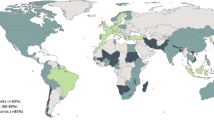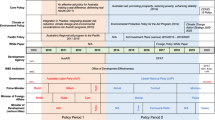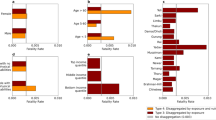Abstract
The recent creation of a loss and damage fund under the United Nations Framework Convention on Climate Change was heralded as a major breakthrough for Global South negotiators. As details of the fund are currently being negotiated, some analysts are calling for ‘objective’ means through which funding would be allocated to ‘particularly vulnerable’ developing countries. On the basis of a review of past debates relating to the identification of priority beneficiaries of international adaptation finance, we caution that such an approach is likely to bring division and delay. Quantitative vulnerability indicators remain conceptually fraught and methodologically complex. Furthermore, the adoption of vulnerability indicators will not fully depoliticize allocation decisions, given the power dynamics between and among contributor and beneficiary countries.
This is a preview of subscription content, access via your institution
Access options
Access Nature and 54 other Nature Portfolio journals
Get Nature+, our best-value online-access subscription
$29.99 / 30 days
cancel any time
Subscribe to this journal
Receive 12 print issues and online access
$209.00 per year
only $17.42 per issue
Buy this article
- Purchase on Springer Link
- Instant access to full article PDF
Prices may be subject to local taxes which are calculated during checkout
Similar content being viewed by others
References
Harvey, F., Morton, A. & Greenfield, P. COP27: EU agrees to loss and damage fund to help poor countries amid climate disasters. The Guardian (18 November 2022); https://www.theguardian.com/environment/2022/nov/18/cop27-eu-agrees-to-loss-and-damage-fund-to-help-poor-countries-recover-from-climate-disasters
Falzon, D. et al. Tactical opposition: obstructing loss and damage finance in the United Nations climate negotiations. Glob. Environ. Politics https://doi.org/10.1162/glep_a_00722 (2023). This article uncovers four periods of L&D finance obstruction and outlines a typology of 14 tactics countries have used to delay progress, knowledge of which can help L&D finance advocates better anticipate and respond to these tactics in future climate negotiations.
Funding Arrangements for Responding to Loss and Damage Associated with the Adverse Effects of Climate Change, Including a Focus on Addressing Loss and Damage Decision -/CP.27 -/CMA.4 (UNFCCC, 2022).
Schipper, E. L. F. Conceptual history of adaptation in the UNFCCC. Rev. Eur. Community Int. Environ. Law 15, 82–92 (2006).
Leiter, T. Too little, too slow? Climate adaptation at the United Nations climate change negotiations since the adoption of the Paris Agreement. Carbon Clim. Law Rev. 16, 243–258 (2022).
Lai, M., Robinson, S., Salas, E., Thao, W. & Shorb, A. Climate justice for small island developing states: identifying appropriate international financing mechanisms for loss and damage. Clim. Policy 22, 1213–1224 (2022).
Khan, M. R., Robinson, S., Weikmans, R., Ciplet, D. & Roberts, J. T. Twenty-five years of adaptation finance through a climate justice lens. Clim. Change 161, 251–269 (2020).
UNFCCC United Nations Framework Convention on Climate Change (United Nations, 1992).
Owen, G. Equity and justice as central components of climate change adaptation. One Earth 4, 1373–1374 (2021).
UNFCCC COP 1: Summary Report, 28 March–7 April 1995 (IISD, 1995); https://enb.iisd.org/events/unfccc-cop-1/summary-report-28-march-7-april-1995
Bali Action Plan (UNFCCC, 2007).
Copenhagen Accord (UNFCCC, 2009).
Cancun Agreements (UNFCCC, 2010).
Ciplet, D., Roberts, J. T. & Khan, M. Power in a Warming World: The New Global Politics of Climate Change and the Remaking of Environmental Inequality (MIT Press, 2015).
The Paris Agreement (UNFCCC, 2015).
Weikmans, R. The Normative Foundations of International Climate Adaptation Finance (Cambridge Univ. Press, 2023).
Horstmann, B. Operationalizing the adaptation fund: challenges in allocating funds to the vulnerable. Clim. Policy 11, 1086–1096 (2011).
Klein, R. J. Identifying countries that are particularly vulnerable to the adverse effects of climate change: an academic or political challenge. Carbon Clim. Law Rev. 3, 284–291 (2009).
Klein, R. J. T. & Mohner, A. The political dimension of vulnerability: implications for the Green Climate Fund. IDS Bull. 42, 15–22 (2011).
Murphy, D., Tirpak, D., Drexhage, J. & Gagnon-Lebrun, F. Encouraging Developing Country Participation in a Future Climate Change Regime (IISD, 2009); https://www.iisd.org/sites/default/files/publications/developing_country_participation_in_climate.pdf
Schalatek, L. A Matter of Principle(s)—A Normative Framework for a Global Compact on Public Climate Finance (Heinrich Böll Foundation, 2010).
Moore, F. C. ‘Doing adaptation’: the construction of adaptive capacity and its function in the international climate negotiations. St Antony’s Int. Rev. 5, 66–88 (2010).
Thomas, D. S. G. & Twyman, C. Equity and justice in climate change adaptation amongst natural-resource-dependent societies. Glob. Environ. Change 15, 115–124 (2005).
Paavola, J. & Adger, N. Fair adaptation to climate change. Ecol. Econ. 56, 594–609 (2006).
Dellink, R. et al. Sharing the burden of financing adaptation to climate change. Glob. Environ. Change 19, 411–421 (2009).
Füssel, H.-M., Hallegatte, S. & Reder, M. in Climate Change, Justice and Sustainability. Linking Climate and Development Policy (eds Eden-Hofer, O. et al.) 311–330 (Springer, 2012).
Stadelmann, M., Persson, A. ̊, Ratajczak-Juszko, I. & Michaelowa, A. Equity and cost-effectiveness of multilateral adaptation finance: are they friends or foes? Int. Environ. Agreem. Politics Law Econ. 14, 101–120 (2014).
Persson, A. & Remling, E. Equity and efficiency in adaptation finance: initial experiences of the adaptation fund. Clim. Policy 14, 488–506 (2014).
Kuhl, L. Policy making under scarcity: reflections for designing socially just climate adaptation policy. One Earth 4, 202–212 (2021).
Ciplet, D., Roberts, J. T. & Khan, M. The politics of international climate adaptation funding: justice and divisions in the greenhouse. Glob. Environ. Politics 13, 49–68 (2013).
Mendelsohn, R. Efficient adaptation to climate change. Clim. Change 45, 583–600 (2000).
Fankhauser, S. & Burton, I. Spending adaptation money wisely. Clim. Policy 11, 1037–1049 (2011).
Arndt, C. The politics of governance ratings. Int. Public Manag. J. 11, 275–297 (2008).
Langbein, L. & Knack, S. The worldwide governance indicators: six, one, or none? J. Dev. Stud. 46, 350–370 (2010).
Betzold, C. & Weiler, F. Allocation of aid for adaptation to climate change: do vulnerable countries receive more support? Int. Environ. Agreem. Politics Law Econ. 17, 17–36 (2017).
Weiler, F., Betzold, C. & Dornan, M. Vulnerability, good governance, or donor interests? The allocation of aid for climate change adaptation. World Dev. 104, 65–77 (2018). In contrast to previous research, this article demonstrates that donors partially take recipient country vulnerability into account when allocating adaptation finance and that countries that are more physically exposed are more likely to receive more aid on a per capita basis, as are low-income countries and SIDS.
Mori, A., Rahman, S. M. & Uddin, M. N. Climate financing through the adaptation fund: what determines fund allocation? J. Environ. Dev. https://doi.org/10.1177/1070496519877483 (2019).
Doshi, D. & Garschagen, M. Understanding adaptation finance allocation: which factors enable or constrain vulnerable countries to access funding? Sustainability 12, 4308 (2020).
Islam, M. M. Distributive justice in global climate finance—recipients’ climate vulnerability and the allocation of climate funds. Glob. Environ. Change 73, 102475 (2022). This article finds that the most vulnerable countries are not receiving the highest amounts of adaptation funding and, similar to a previous study41, also finds that countries receive decreasing amounts beyond a certain level of vulnerability.
Robertsen, J., Francken, N. & Molenaers, N. Determinants of the Flow of Bilateral Adaptation-Related Climate Change Financing to Sub-Saharan African Countries LICOS Discussion Paper 373 (Catholic Univ. Leuven, 2015).
Saunders, N. Climate Change Adaptation Finance: Are the Most Vulnerable Nations Prioritised? (Stockholm Environment Institute, 2019); www.sei.org/wp-content/uploads/2019/04/climate-change-adaptation-finance-are-the-most-vulnerable-nations-prioritised.pdfIn contrast to previous research, this working paper finds that the relationship between climate vulnerability and adaptation finance is concave, and presents evidence of diminishing and then negative returns to vulnerability.
Michaelowa, K., Michaelowa, A., Reinsberg, B. & Shishlov, I. Do multilateral development bank trust funds allocate climate finance efficiently? Sustainability 12, 5529 (2020).
Garschagen, M. & Doshi, D. Does funds-based adaptation finance reach the most vulnerable countries? Glob. Environ. Change 73, 102450 (2022). This article finds that many of the most vulnerable countries, particularly African LDCs, have not been able to access GCF funds and that institutional capacity is an important factor in determining a country’s access to funds but not whether it actually gets funds.
Climate Finance Provided and Mobilised by Developed Countries in 2016–2020: Insights from Disaggregated Analysis (OECD, 2022); https://doi.org/10.1787/286dae5d-en
Robinson, S. & Dornan, M.International financing for climate change adaptation in small island developing states. Reg. Environ. Change https://doi.org/10.1007/s10113-016-1085-1 (2017).
Reckien, D. What is in an index? Construction method, data metric, and weighting scheme determine the outcome of composite social vulnerability indices in New York City. Reg. Environ. Change 18, 1439–1451 (2018).
Weiler, F. & Kloeck, C. Donor interactions in the allocation of adaptation aid: a network analysis. Earth Syst. Gov. 7, 100099 (2021).
Füssel, H.-M. & Klein, R. J. T. Climate change vulnerability assessments: an evolution of conceptual thinking. Clim. Change 75, 301–329 (2006).
O’Brien, K., Eriksen, S., Nygaard, L. P. & Schjolden, A. N. E. Why different interpretations of vulnerability matter in climate change discourses. Clim. Policy 7, 73–88 (2007).
IPCC Climate Change 2001: Impacts, Adaptation, and Vulnerability (Cambridge Univ. Press, 2001).
IPCC Managing the Risks of Extreme Events and Disasters to Advance Climate Change Adaptation 32 (Cambridge Univ. Press, 2012).
IPCC Climate Change 2014: Impacts, Adaptation, and Vulnerability (Cambridge Univ. Press, 2014).
IPCC Climate Change 2022: Impacts, Adaptation and Vulnerability (Cambridge Univ. Press, 2022).
Otto, I. M. et al. Social vulnerability to climate change: a review of concepts and evidence. Reg. Environ. Change 17, 1651–1662 (2017).
Araos, M. et al. Equity in human adaptation-related responses: a systematic global review. One Earth 4, 1454–1467 (2021).
Weikmans, R. Comprendre la mobilisation financière internationale autour de l’aide à l’adaptation au changement climatique. Crit. Int. 4, 121–139 (2017).
Sharma, J. & Ravindranath, N. H. Applying IPCC 2014 framework for hazard-specific vulnerability assessment under climate change. Environ. Res. Commun. 1, 051004 (2019).
Barnett, J., Lambert, S. & Fry, I. The hazards of indicators: insights from the environmental vulnerability index. Ann. Assoc. Am. Geogr. 98, 102–119 (2008). This article focuses on the EVI and warns against the use of quantitative indicators for measuring environmental performance, comparing countries and/or allocating finance.
Kaly, U. et al. Environmental Vulnerability Index (EVI) to Summarise National Environmental Vulnerability Profiles SOPAC Technical Report 275 (SOPAC, 1999); https://www.researchgate.net/publication/267821112_Environmental_Vulnerability_Index_EVI_to_summarise_national_environmental_vulnerability_profiles
Climate Vulnerability Monitor 2010: The State of the Climate Crisis (DARA, CVF, 2010); https://daraint.org/wp-content/uploads/2010/12/CVM_E-01082011.pdf
ND-GAIN Notre Dame Global Adaptation Initiative (ND-GAIN) (Univ. Notre Dame, 2023); https://gain.nd.edu/our-work/country-index/methodology/
Busby, J., Smith, T. & Krishnan, N. Climate security vulnerability in Africa mapping 3.0. Political Geogr. 43, 51 (2014).
Kaly, U., Pratt, C. R. & Mitchell, J. The Environmental Vulnerability Index (EVI) 2004 SOPAC Technical Report 384 (SOPAC, 2004); https://gsd.spc.int/sopac/evi/Files/EVI%202004%20Technical%20Report.pdf
Nazari Nooghabi, S. et al. Social, economic and environmental vulnerability: the case of wheat farmers in Northeast Iran. Sci. Total Environ. 816, 151519 (2022).
Baishakhy, S. D., Islam, M. A. & Kamruzzaman, M. Overcoming barriers to adapt rice farming to recurring flash floods in haor wetlands of Bangladesh. Heliyon 9, e14011 (2023).
Thomas, K. et al. Explaining differential vulnerability to climate change: a social science review. Wiley Interdiscip. Rev. Clim. Change https://doi.org/10.1002/wcc.565 (2018). This article focuses on disproportionate climate vulnerability and encourages attention on the root causes of vulnerability.
Rufat, S., Tate, E., Emrich, C. T. & Antolini, F. How valid are social vulnerability models? Ann. Am. Assoc. Geogr. 109, 1131–1153 (2019).
Roberts, J. T. & Weikmans, R. Fragmentation, failing trust and enduring tensions over what counts as climate finance. Int. Environ. Agreem. Politics Law Econ. 17, 129–137 (2017).
Robinson, S. Climate change adaptation in SIDS: a systematic review of the literature pre and post the IPCC Fifth Assessment Report. Wiley Interdiscip. Rev. Clim. Change https://doi.org/10.1002/wcc.653 (2020).
Foley, A. et al. Understanding ‘islandness’. Ann. Am. Assoc. Geogr. https://doi.org/10.1080/24694452.2023.2193249 (2023).
CVF Members (CVF, 2022); https://thecvf.org/members/
Takayabu, I. et al. Climate change effects on the worst-case storm surge: a case study of Typhoon Haiyan. Environ. Res. Lett. 10, 064011 (2015).
Lagmay, A. M. F. et al. Devastating storm surges of Typhoon Haiyan. Int. J. Disaster Risk Reduct. 11, 1–12 (2015).
Randil, C., Siriwardana, C. & Sandaruwan Rathnayaka, B. A statistical method for pre-estimating impacts from a disaster: a case study of floods in Kaduwela, Sri Lanka. Int. J. Disaster Risk Reduct. 76, 103010 (2022).
Robinson, S. & Carlson, D. A just alternative to litigation: applying restorative justice to climate-related loss and damage. Third World Q. 42, 1384–1395 (2021).
Sultana, F. The unbearable heaviness of climate coloniality. Political Geogr. 99, 102638 (2022).
Robinson, S. Climate change adaptation trends in small island developing states. Mitig. Adapt. Strateg. Glob. Change 22, 669–691 (2017).
Anjum, G. & Fraser, A. Vulnerabilities associated with slow-onset events (SoEs) of climate change: multi-level analysis in the context of Pakistan. Curr. Opin. Environ. Sustain. 50, 54–63 (2021).
Weikmans, R., Roberts, J. T., Baum, J., Bustos, M. C. & Durand, A. Assessing the credibility of how climate adaptation aid projects are categorised. Dev. Pract. 27, 458–471 (2017).
Roberts, J. T. et al. Rebooting a failed promise of climate finance. Nat. Clim. Change https://doi.org/10.1038/s41558-021-00990-2 (2021).
Füssel, H.-M. How inequitable is the global distribution of responsibility, capability, and vulnerability to climate change: a comprehensive indicator-based assessment. Glob. Environ. Change 20, 597–611 (2010).
Malcomb, D. W., Weaver, E. A. & Krakowka, A. R. Vulnerability modeling for sub-Saharan Africa: an operationalized approach in Malawi. Appl. Geogr. 48, 17–30 (2014).
Nightingale, A. J. Power and politics in climate change adaptation efforts: struggles over authority and recognition in the context of political instability. Geoforum 84, 11–20 (2017).
Estoque, R. C. et al. Has the IPCC’s revised vulnerability concept been well adopted? Ambio 52, 376–389 (2022).
Ford, J. D. et al. Vulnerability and its discontents: the past, present, and future of climate change vulnerability research. Clim. Change 151, 189–203 (2018). This article tracks and evaluates concerns over the use of vulnerability approaches in climate change research and calls for efforts to revitalize vulnerability research with emphasis to be placed on developing new empirical studies that bridge research and practice.
Kuhlicke, C. et al. Spinning in circles? A systematic review on the role of theory in social vulnerability, resilience and adaptation research. Glob. Environ. Change 80, 102672 (2023).
Funtowicz, S. From risk calculations to narratives of danger. Clim. Risk Manag. https://doi.org/10.1016/j.crm.2020.100212 (2020).
Pickering, J., Vanderheiden, S. & Miller, S. Ethical Issues in the United Nations Climate Negotiations: A Preliminary Analysis of Parties’ Positions (Centre for Applied Philosophy and Public Ethics, 2009); https://www.researchgate.net/profile/Seumas-Miller/publication/228384390_Ethical_issues_in_the_United_Nations_climate_negotiations_a_preliminary_analysis_of_parties%27_positions/links/0f31752e2ed720e778000000/Ethical-issues-in-the-United-Nations-climate-negotiations-a-preliminary-analysis-of-parties-positions.pdf
Robinson, S. in Limits to Climate Change Adaptation (eds Leal, F. W. & Nalau, J.) Ch. 14, 263–281 (Springer, 2018); https://doi.org/10.1007/978-3-319-64599-5_15
Eriksen, S. H., Nightingale, A. J. & Eakin, H. Reframing adaptation: the political nature of climate change adaptation. Glob. Environ. Change 35, 523–533 (2015).
Barnett, J. Global environmental change II: political economies of vulnerability to climate change. Prog. Hum. Geogr. 44, 1172–1184 (2020). This progress report emphasizes that climate vulnerability is fundamentally an issue of the political economy and explains the relationship between constructions of vulnerability, the actors with interests in it and the institutions that create it.
Béné, C., Wood, R. G, Newsham, A. & Davies, M. Resilience: New Utopia or New Tyranny? (IDS, 2012); http://www.ids.ac.uk/files/dmfile/Wp405.pdf
Acknowledgements
We thank C. Jones, H. August, Q. Roberts and T. Culver for early research assistance. This work was supported by the Academy of Finland under grant no. 333127 (R.W.).
Author information
Authors and Affiliations
Contributions
S.R., J.T.R., R.W. and D.F. all made significant contributions to the conceptualization, drafting and revision of this work.
Corresponding author
Ethics declarations
Competing interests
The authors declare no competing interests.
Peer review
Peer review information
Nature Climate Change thanks Florian Weiler, Md. Mofakkarul Islam and Siri Eriksen for their contribution to the peer review of this work.
Additional information
Publisher’s note Springer Nature remains neutral with regard to jurisdictional claims in published maps and institutional affiliations.
Rights and permissions
Springer Nature or its licensor (e.g. a society or other partner) holds exclusive rights to this article under a publishing agreement with the author(s) or other rightsholder(s); author self-archiving of the accepted manuscript version of this article is solely governed by the terms of such publishing agreement and applicable law.
About this article
Cite this article
Robinson, Sa., Roberts, J.T., Weikmans, R. et al. Vulnerability-based allocations in loss and damage finance. Nat. Clim. Chang. 13, 1055–1062 (2023). https://doi.org/10.1038/s41558-023-01809-y
Received:
Accepted:
Published:
Issue Date:
DOI: https://doi.org/10.1038/s41558-023-01809-y



